The AMD Threadripper 2990WX 32-Core and 2950X 16-Core Review
by Dr. Ian Cutress on August 13, 2018 9:00 AM ESTHEDT Benchmarks: Rendering Tests
Rendering is often a key target for processor workloads, lending itself to a professional environment. It comes in different formats as well, from 3D rendering through rasterization, such as games, or by ray tracing, and invokes the ability of the software to manage meshes, textures, collisions, aliasing, physics (in animations), and discarding unnecessary work. Most renderers offer CPU code paths, while a few use GPUs and select environments use FPGAs or dedicated ASICs. For big studios however, CPUs are still the hardware of choice.
Corona 1.3: Performance Render
An advanced performance based renderer for software such as 3ds Max and Cinema 4D, the Corona benchmark renders a generated scene as a standard under its 1.3 software version. Normally the GUI implementation of the benchmark shows the scene being built, and allows the user to upload the result as a ‘time to complete’.
We got in contact with the developer who gave us a command line version of the benchmark that does a direct output of results. Rather than reporting time, we report the average number of rays per second across six runs, as the performance scaling of a result per unit time is typically visually easier to understand.
The Corona benchmark website can be found at https://corona-renderer.com/benchmark
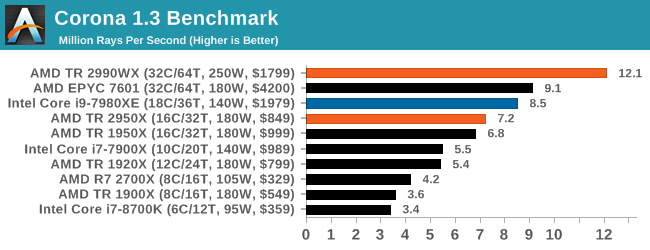
So this is where AMD broke our graphing engine. Because we report Corona in rays per second, having 12 million of them puts eight digits into our engine, which it then tries to interpret as a scientific number (1.2 x 10^7), which it can’t process in a graph. We had to convert this graph into millions of rays per second to get it to work.
The 2990WX hits out in front with 32 cores, with its higher frequency being the main reason it is so far ahead of the EPYC processor. The EPYC and Core i9 are close together, however the TR2950X at half the cost comes reasonably close.
Blender 2.79b: 3D Creation Suite
A high profile rendering tool, Blender is open-source allowing for massive amounts of configurability, and is used by a number of high-profile animation studios worldwide. The organization recently released a Blender benchmark package, a couple of weeks after we had narrowed our Blender test for our new suite, however their test can take over an hour. For our results, we run one of the sub-tests in that suite through the command line - a standard ‘bmw27’ scene in CPU only mode, and measure the time to complete the render.
Blender can be downloaded at https://www.blender.org/download/
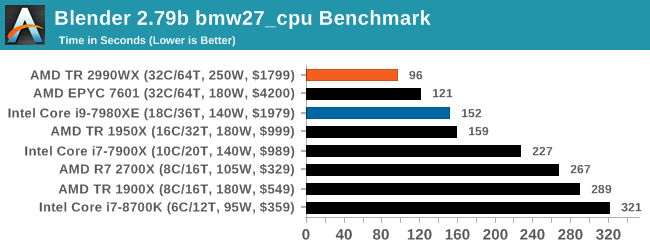
The additional cores on the 2990WX puts it out ahead of the EPYC and Core i9, with the 2990WX having an extra 58% throughput over the Core i9. That is very substantial indeed.
LuxMark v3.1: LuxRender via Different Code Paths
As stated at the top, there are many different ways to process rendering data: CPU, GPU, Accelerator, and others. On top of that, there are many frameworks and APIs in which to program, depending on how the software will be used. LuxMark, a benchmark developed using the LuxRender engine, offers several different scenes and APIs.

Taken from the Linux Version of LuxMark
In our test, we run the simple ‘Ball’ scene on both the C++ and OpenCL code paths, but in CPU mode. This scene starts with a rough render and slowly improves the quality over two minutes, giving a final result in what is essentially an average ‘kilorays per second’.
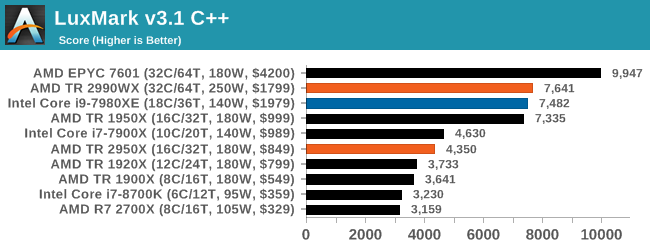
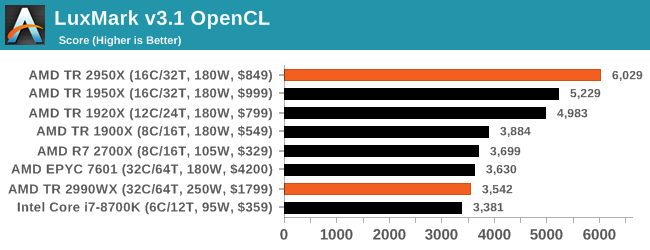
Intel’s Skylake-X processors seem to fail our OpenCL test for some reason, but in the C++ test the extra memory controllers on EPYC sets it ahead of both TR2 and Core i9. The 2990WX and Core i9 are almost equal here.
POV-Ray 3.7.1: Ray Tracing
The Persistence of Vision ray tracing engine is another well-known benchmarking tool, which was in a state of relative hibernation until AMD released its Zen processors, to which suddenly both Intel and AMD were submitting code to the main branch of the open source project. For our test, we use the built-in benchmark for all-cores, called from the command line.
POV-Ray can be downloaded from http://www.povray.org/

This test is another that loves the cores and frequency of the 2990WX, finishing the benchmark in almost 20 seconds. It might be time for a bigger built-in benchmark.


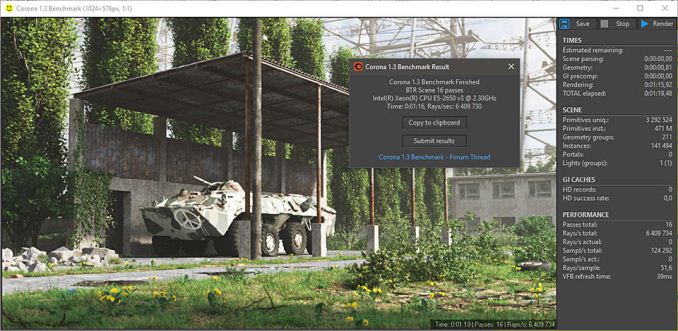








171 Comments
View All Comments
eva02langley - Tuesday, August 14, 2018 - link
You don't get it, it is a proof of concept and a disruptive tactic to get notice for people to consider AMD in the future... and it works perfectly.KAlmquist - Thursday, August 16, 2018 - link
That's what I meant by “bragging rights.”eva02langley - Thursday, August 16, 2018 - link
You are missing the business standpoint, the stakeholders and the proof of concept.Nvidia is surfing on AI, however the only thing they did so far is selling GPU during a mining craze, however people drink their coolaid and the investors are all over them. The hangover is going to be hard.
Lolimaster - Monday, August 13, 2018 - link
If you're a content creator the Threaripper 2950X is you bitch, period.MrSpadge - Tuesday, August 14, 2018 - link
Ian, does the power consumption of uncore (IF + memory controller) scale with IF + memory controller frequency? I would expect so. And if not: maybe AMD is missing on huge possible power savings at lower frequencies. Not sure if overall efficiency could benefit from that, though, as performance and power would simulataneously regress.dynamis31 - Tuesday, August 14, 2018 - link
It's not all silicon !Windows OS and applications running on that OS may also be software optimised for more 2990WX workloads as you can see below :
https://www.phoronix.com/forums/forum/phoronix/lat...
dmayo - Tuesday, August 14, 2018 - link
Meanwhile, in Linux 2990WX destroyed competition.https://www.phoronix.com/scan.php?page=article&...
https://www.phoronix.com/scan.php?page=article&...
eva02langley - Tuesday, August 14, 2018 - link
I am beginning to ask myself if this is related to Windows. Or maybe the bench suites reliability toward such a unique product.But yeah, these results are insane.
MrSpadge - Tuesday, August 14, 2018 - link
Crazy results, indeed. And quite believable, considering how well the 16 core TR fares in comparison in many windows benches. I suspect the scheduler is not yet tuned for the new architecture with 2 different NUMA levels.And for at least parts of the benchmarks I suspect something a lot less technical is happening: Phoronix can only bench cross-platform software for this comparison. However, hardly any Windows programmer is regularly building Linux versions. That leaves just another option: Linux programs which also got a Windows build. And considering how downright hostile Linux fans can be towards Windows and anything Microsoft-related, I wouldn't be surprised if the tuning going into these compilations was far from ideal. Some of these guys really enjoy shouting out loud that they don't have access to any Windows machine to test their build (which they only did to stop the requests flooding their inbox) and to shove down their users throat that Windows is a second class citizen in their world. This point is reinforced by the wierd names of many of the benchmarks - except 7-zip, is anyone using those programs?
GreenReaper - Wednesday, August 15, 2018 - link
Most aren't dedicated benchmarks, they're useful programs being run as such:* x264 powers most CPU-based H.264/AVC video encoding. Steam uses it, for example.
* GraphicsMagick is a fork of ImageMagick, one of which is used in a large number of websites (probably including this one) for processing images.
* FFmpeg is for audio and video processing.
* Blender is a popular open-source rendering tool.
* Minion is for constraint-solving (e.g. the four-colour map problem).
Many aren't the kind of things you'd run on a regular desktop - but a workstation, sure. They are CPU-intensive parallel tasks which scale - or you hope will scale - with threads.